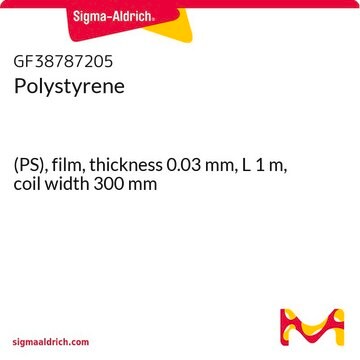Products may be shipped at a different temperature than the recommended long-term storage temperature. If the product quality is sensitive to short-term exposure to conditions other than the recommended long-term storage, it will be shipped on wet or dry-ice. If the product quality is NOT affected by short-term exposure to conditions other than the recommended long-term storage, it will be shipped at ambient temperature. As shipping routes are configured for minimum transit times, shipping at ambient temperature helps control shipping costs for our customers. For more information, please refer to the Storage and Transport Conditions document: https://www.sigmaaldrich.com/deepweb/assets/sigmaaldrich/marketing/global/documents/316/622/storage-transport-conditions-mk.pdf
331651
Polystyrene
average Mw 35,000
Synonyme(s) :
PS
About This Item
Produits recommandés
Forme
beads or pellets
Poids mol.
average Mw 35,000
Température de transition
softening point (ASTM E 28) 123-128 °C
Densité
1.06 g/mL at 25 °C
InChI
1S/C8H8/c1-2-8-6-4-3-5-7-8/h2-7H,1H2
Clé InChI
PPBRXRYQALVLMV-UHFFFAOYSA-N
Vous recherchez des produits similaires ? Visite Guide de comparaison des produits
Description générale
Application
It can be used to stabilize the perovskite component by forming PS-capped perovskite grains. This PS coverage can suppress the organic component evaporation, and water corrosion and promotes crystal self-healing of perovskite films.
Due to its optical clarity, low production cost, and ease ofmanufacture, it is widely used as a fundamental substrate for in vitrocell culture.
Caractéristiques et avantages
- Thermal efficiency
- Durability
- Moisture resistance
Forme physique
Code de la classe de stockage
11 - Combustible Solids
Classe de danger pour l'eau (WGK)
WGK 3
Point d'éclair (°F)
Not applicable
Point d'éclair (°C)
Not applicable
Équipement de protection individuelle
Eyeshields, Gloves, type N95 (US)
Faites votre choix parmi les versions les plus récentes :
Déjà en possession de ce produit ?
Retrouvez la documentation relative aux produits que vous avez récemment achetés dans la Bibliothèque de documents.
Les clients ont également consulté
-
How is shipping temperature determined? And how is it related to the product storage temperature?
1 answer-
Helpful?
-
-
How can I determine the shelf life / expiration / retest date of this product?
1 answer-
If this product has an expiration or retest date, it will be shown on the Certificate of Analysis (COA, CofA). If there is no retest or expiration date listed on the product's COA, we do not have suitable stability data to determine a shelf life. For these products, the only date on the COA will be the release date; a retest, expiration, or use-by-date will not be displayed.
For all products, we recommend handling per defined conditions as printed in our product literature and website product descriptions. We recommend that products should be routinely inspected by customers to ensure they perform as expected.
For products without retest or expiration dates, our standard warranty of 1 year from the date of shipment is applicable.
For more information, please refer to the Product Dating Information document: https://www.sigmaaldrich.com/deepweb/assets/sigmaaldrich/marketing/global/documents/449/386/product-dating-information-mk.pdfHelpful?
-
-
What is the number molecular weight of this polystyrene? Do you have a GPC cromatogram of this polystyrene?
1 answer-
This product has an approximate molecular weight of 35,000. In regards to the GPC Chromatogram, please navigate to the link https://www.sigmaaldrich.com/techservice, click on "Product Technical Inquiries" under the Products Section with all the required information so that a member of the Technical Service team can reach out to assist further. Thank you.
Helpful?
-
Active Filters
Notre équipe de scientifiques dispose d'une expérience dans tous les secteurs de la recherche, notamment en sciences de la vie, science des matériaux, synthèse chimique, chromatographie, analyse et dans de nombreux autres domaines..
Contacter notre Service technique


